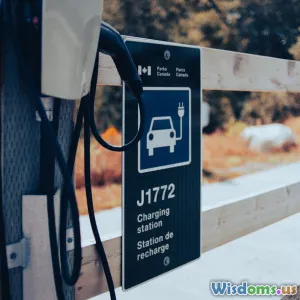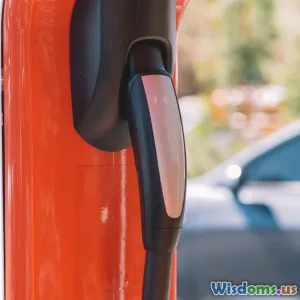
How Electric Cars Perform in Extreme Cold Weather Conditions
8 min read Discover how electric cars handle freezing temperatures and what this means for their performance and your driving experience in cold climates. (0 Reviews)
How Electric Cars Perform in Extreme Cold Weather Conditions
Electric vehicles (EVs) have surged in popularity thanks to their sustainability and efficiency—but how well do they fare when temperatures plunge well below freezing? Extreme cold weather presents unique challenges for electric cars, affecting everything from battery performance and driving range to charging time. In this article, we’ll explore how freezing conditions impact electric vehicles, why these effects occur, and what automakers and drivers can do to optimize performance in deep winter.
The Chill Factor: Why Cold Weather Challenges Electric Vehicles
Electric cars rely heavily on lithium-ion batteries, which are sensitive to temperature changes. Chemical reactions inside the battery decrease in speed and efficiency as temperatures fall, directly affecting a car’s ability to deliver power and accept charge.
At subzero temperatures, the electrolyte inside the battery becomes less conductive, increasing internal resistance. This leads to lower voltage output and slower charging times. Moreover, the car’s heating system draws additional power to keep the cabin warm, further reducing the available energy for driving.
Consider that a typical EV may see a range reduction of about 30% or more during winter months compared to optimal temperatures. For comparison, a 300-mile range at room temperature might shrink to approximately 210 miles in severe cold.
Battery Efficiency Drops: The Impact on Range and Longevity
Studies from the Department of Energy and various automotive research institutes confirm that lithium-ion battery efficiency decreases markedly at temperatures below 20°F (-6°C). A 2022 study by Argonne National Laboratory highlighted that extreme cold can reduce EV driving range by 20-40%, with older batteries experiencing greater losses.
Real-World Evidence
Many EV owners in regions like Canada, Scandinavia, and the northern United States report daily range variances when temperatures drop. For example, Tesla drivers in Minnesota often adjust their winter expectations accordingly, using trip planners integrated into Tesla’s systems that factor in temperature-based range reduction.
Battery Longevity: Cold temperatures, if managed properly, generally do not damage EV batteries long-term. However, frequent deep discharge combined with cold climate stress can accelerate degradation. Manufacturers typically recommend maintaining battery charge between 20% and 80% and preconditioning the battery (warming it up before use) to prolong battery life.
Charging Challenges in the Cold
Cold weather affects not only the available range but also the speed at which electric cars can recharge. Lithium-ion batteries charge more slowly at low temperatures because the battery management systems (BMS) actively prevent charging that could damage the cells.
Fast Charging Limitations
Fast-charging stations may deliver reduced power in freezing conditions to protect battery health, extending charging times. For instance, a Supercharger designed to deliver 250 kW might throttle output significantly in extreme cold.
Manufacturers such as Chevrolet and Nissan employ battery heaters during charging sessions to improve efficiency during cold weather, but these systems consume additional power.
Vehicle Performance and Handling in Subzero Climates
Beyond the battery, the overall vehicle performance in cold weather is another concern. Teslas and other electric cars tend to have excellent traction thanks to the instant torque and sophisticated traction control systems. However, cold weather thickens lubricants in the drivetrain and tires lose pressure more quickly, which can impact handling.
Winter tires are strongly encouraged for electric cars operating in these environments. Studies show that the added grip directly improves both safety and energy efficiency, counteracting some losses related to cold weather.
Innovations and Solutions: How Automakers Combat the Cold
Battery Thermal Management Systems (BTMS)
Most modern EVs come equipped with sophisticated thermal management systems to keep batteries within an optimal temperature window. For example, the 2024 Ford Mustang Mach-E utilizes active liquid cooling and heating to warm the battery before driving and during charging.
Preconditioning Features
EVs increasingly offer preconditioning via smartphone apps, allowing drivers to heat the battery and interior while the vehicle is still plugged in, preserving range and improving comfort. The Chevrolet Bolt EV and Hyundai Ioniq Electric both support this feature.
Efficiency Enhancements
Manufacturers are improving insulation around batteries and incorporating heat pumps to enhance heating efficiency. Heat pumps can use ambient heat more effectively than traditional resistive heaters, reducing the energy drain caused by winter heating.
Practical Tips for EV Drivers in Extreme Cold
- Preheat While Plugged In: Use preconditioning features to warm the battery and cabin before unplugging.
- Use Winter Tires: Maintain better traction and efficiency in snow or ice.
- Plan Charging: Anticipate slower charging and longer trip times.
- Charge More Frequently: Avoid deep discharges in cold temperatures to preserve battery health.
- Monitor Tire Pressure: Cold shrinks air and deflates tires, increasing rolling resistance.
Conclusion: Electric Cars Can Handle the Cold, But With Preparation
Extreme cold weather undoubtedly affects electric car performance, mainly through reduced battery efficiency, shorter driving range, and slower charging times. Yet, advancements in battery thermal management, vehicle preconditioning, and improved winter accessories mean that EVs are increasingly capable of delivering reliable, safe, and comfortable transportation even in the harshest climates.
By understanding these cold weather impacts and adapting driving habits intelligently, EV owners in freezing environments can enjoy the benefits of electric mobility year-round. As technology continues to evolve, we can expect even better cold-weather resilience from electric vehicles, making them a truly global transportation solution.
References
- U.S. Department of Energy, Office of Energy Efficiency & Renewable Energy
- Argonne National Laboratory, Battery Testing Reports, 2022
- Tesla Cold Weather User Data and Forums, 2023
- Manufacturer Technical Briefs: Ford, Chevrolet, Hyundai
- Tire Testing Reports, Winter Grip and Efficiency, Consumer Reports
Rate the Post
User Reviews
Popular Posts


















